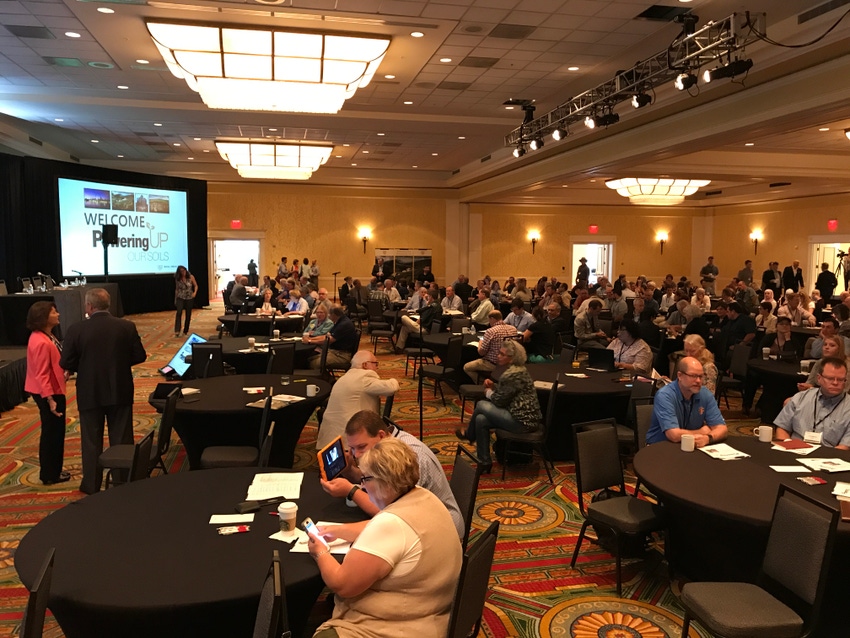July 14, 2017

The Soil Health Institute brought together a wide variety of stakeholders in St. Louis this week to continue building consensus around the productivity of your soils. Soil scientists, plant pathologists, educators, government officials, economists, farmers, ag retailers, consultants, food and fiber retailers and more met to discuss all aspects of the Soil Health Institute’s (SHI) Action Plan, just launched in mid-May.
#SoilHealth the big topic today and tomorrow pic.twitter.com/Q8R0uQATSi
— Corn-Soybean Digest (@csdigest) July 13, 2017
SHI, created in 2013 by the Samuel Roberts Noble Foundation and the Farm Foundation – led by the visionary Bill Buckner – aims “to reverse the centuries of soil neglect and abuse, and rebuild the whole soil biome that will transform the entire agricultural industry,” he says.
Bill Buckner, visionary of Soil Health Institute, talks how #SoilHealth will transform entire agricultural industry pic.twitter.com/hJSVRlOYuA
— Corn-Soybean Digest (@csdigest) July 13, 2017
SHI’s President and CEO, Wayne Honeycutt, discussed their mission – to safeguard and enhance the vitality and productivity of soil through scientific research and advancement.
President CEO of Soil Health Institute Wayne Honeycutt talks #SoilHealth action plan https://t.co/wLx1ktQVmz pic.twitter.com/BqcEmNcyqh
— Corn-Soybean Digest (@csdigest) July 13, 2017
He also emphasized the critical roles of SHI:
Identify research & adoption gaps
Build research/implementation strategies and corresponding networks/synergies
Obtain funding to strategically address gaps
Administer accountable, transparent, and technically proficient grants program
Ensure impact of investments
Incorporate research results into educational materials
Mission and roles of Soil Health Institute #SoilHealth pic.twitter.com/ridt2kWxKN
— Corn-Soybean Digest (@csdigest) July 13, 2017
Honeycutt reviewed the SHI Action Plan: Enriching Soil, Enhancing Life, walking through each committee area to be discussed: Research; Measurements, Standards & Assessments; Policy; Economics; and Communications & Education.
Developing economics of #SoilHealth is one key factor to build success, sustainability. pic.twitter.com/Qt1lAWjIte
— Corn-Soybean Digest (@csdigest) July 13, 2017
Co-chair of the Research committee, Doug Karlen, a USDA-ARS soil scientist, highlighted the need for federal and state partners; the value of AgSolver modeling to improve ROI on fields; the soil and human health linkage; the inclusion of erosion for soil health assessment; and many other research project benefits.
Dr Doug Karlen, USDA ARS soil scientist, co-chairs team to examine all aspects of #SoilHealth pic.twitter.com/cYGUGAIZYy
— Corn-Soybean Digest (@csdigest) July 13, 2017
Bob Larkin, USDA-ARS plant pathologist, discussed research on the importance of understanding the phytobiomes to enable sustainable and profitable crop production while minimizing negative impacts on the environment.
Dr Bob Larkin, USDA ARS plant pathologist, talks phytobiome, #SoilHealth and disease mgmt pic.twitter.com/VhASWVRO7Z
— Corn-Soybean Digest (@csdigest) July 13, 2017
USDA-ARS soil scientist, Dan Manter, drove home the importance of the disease triangle, and how biological is the key influencer regarding disease suppression.
Dr Dan Manter, USDA ARS soil scientist, talks importance of soil biology aspects to improve #SoilHealth pic.twitter.com/Mt3mEWYt5W
— Corn-Soybean Digest (@csdigest) July 13, 2017
He showed an example of improved potato quality and quantity when a sorghum sudangrass cover crop is used.
Manter highlights potato yield and quality benefit research with sorghum Sudan cover crop. #SoilHealth pic.twitter.com/L9M5fiS7Kp
— Corn-Soybean Digest (@csdigest) July 13, 2017
Keith Paustian, Colorado State University crops and soils research scientist, discussed the key principles of soil carbon sequestration: duration is finite, storage is limited, depleated soils have greatest gain capacity but least propensity to do so, and soil; carbon gains are reversible so practices must remain.
Dr Keith Paustian, Colo State Univ, examines soil carbon sequestration. #SoilHealth pic.twitter.com/Bp0Qb7WpiA
— Corn-Soybean Digest (@csdigest) July 13, 2017
Paustian believes soil carbon can play a crucial role in global GHG mitigation, but the biggest unknown is adoption rates, as what policies and incentives can achieve the highest and lowest cost rates?
Paustian believes soil carbon can be sequestered, with effort. #SoilHealth pic.twitter.com/RAGEDfXE2y
— Corn-Soybean Digest (@csdigest) July 13, 2017
And Paustian says let’s get nitrogen where it belongs…
Paustian says let’s get nitrogen into soil organic matter and not into streams and rivers. #SoilHealth
— Corn-Soybean Digest (@csdigest) July 13, 2017
Regarding the Measurement, Standards, and Assessment team, Honeycutt discussed the national strategy, and the $2 million funding by General Mills for a long-term ag experiments directory project – map shows more than 200 sites to develop further testing.
Dr Honeycutt talks potential research sites to measure and assess #SoilHealth with funding from General Mills pic.twitter.com/dHwKhIUvm7
— Corn-Soybean Digest (@csdigest) July 13, 2017
SHI’s chief science officer, Steve Shafer, discussed priority-tiered research to characterize soil health measurement.
Dr Steve Shafer, Soil Health Institute chief science officer, talks tiers of #SoilHealth measurement. pic.twitter.com/svJZRrSbwz
— Corn-Soybean Digest (@csdigest) July 13, 2017
Regarding the Policy team, Rob Myers, USDA regional director of SARE program, highlighted the momentum behind possible scenarios to incentivize cover crops through the crop insurance program.
Dr Rob Myers, USDA ARS, talks potential for tying #SoilHealth with crop insurance. pic.twitter.com/tHbEZxcR3X
— Corn-Soybean Digest (@csdigest) July 13, 2017
Tim Griffin, ag science and policy professor at Tufts University, helped define policy and program terms – from Farm Bill legislation, state government inclusion, corporate policy and NGOs, plus implementation of policy like EQIP to meet conservation goals.
Dr Tim Griffin, Tufts Univ prof, working on policy team toward advancing #SoilHealth. pic.twitter.com/wLvnwzk6dp
— Corn-Soybean Digest (@csdigest) July 13, 2017
Regarding the Economics team, Matt Bechdol, owner and consultant of GeoSilos, discussed their goals and priorities from the SHI Action Plan:
Develop partial budgets useful for assisting producers in evaluating profitability of soil health management practices and systems.
Establish approaches for monitization of soil health.
Quantify economic risk of soil health management systems
Matt Bechdol, owner consultant of GeoSilos, helping drive economic needs of #SoilHealth efforts pic.twitter.com/ckjOzscFDk
— Corn-Soybean Digest (@csdigest) July 13, 2017
Debbie Reed, Executive Director of Coalition on Agricultural Greenhouse Gases (C-AGG) talked about creating voluntary, sustainable, incentive-based agriculture and climate change solutions for farmers, ranchers and society.
Debbie Reed, Exec Dir of C-AGG, talks sustainable voluntary ag and climate and #SoilHealth change pic.twitter.com/GSZsoDi7ex
— Corn-Soybean Digest (@csdigest) July 13, 2017
Reed also discussed the impact of soil health changes to agricultural management systems – such as these 3 related public policy impacts of reduced soil erosion:
U.S. Army Corps of Engineers spent $1.32 billion in 2016 dredging just over 200,000 cubic yards material from navigable waterways.
Combined annual costs to society of wind and water erosion at $43 to $59 billion (2006 dollars).
1 ton soil lost from farmland carries $2 to $3 fertilizer (N and phosphate)
Reed talks to impact of #SoilHealth changes to agriculture management systems. pic.twitter.com/HobQYQbxHh
— Corn-Soybean Digest (@csdigest) July 13, 2017
Regarding Communications and Education team, NRCS soil health communications coordinator, Ron Nichols, discussed their vision:
Connect groups with similar soil health objectives.
Share soil health communication resources and information.
Amplify messages and successes from soil health organizations, individuals and community.
Identify other communications strategies/tactics to advance soil health effort via the Soil Health Institute.
Ron Nichols, NRCS #SoilHealth communications coordinator, talks vision of communications and education vision. pic.twitter.com/3qGjm2afkg
— Corn-Soybean Digest (@csdigest) July 13, 2017
Rob Myers highlighted the numerous audiences, messages and strategies used to promote soil health – from the NRCS “Unlock the Secrets in the Soil” campaign and farmer video stories to ag retailer, landowner and consumer messages.
Dr Rob Myers, USDA reg dir SARE programs, highlights great farmer #SoilHealth stories and more. pic.twitter.com/5ILfJYBLYy
— Corn-Soybean Digest (@csdigest) July 13, 2017
About the Author(s)
You May Also Like






